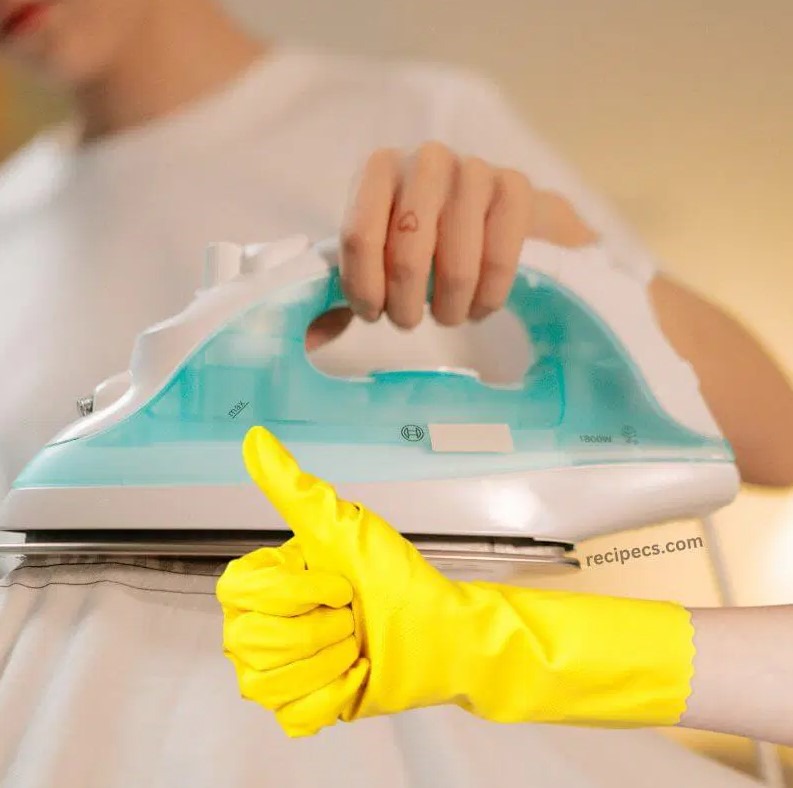ADVERTISEMENT
Method 1: Baking Soda Paste
- Mix 2 tablespoons of baking soda with a little water to form a thick paste.
- Unplug the iron and let it cool.
- Apply the paste directly onto the soleplate using a soft cloth or sponge.
- Gently scrub the plate in circular motions, focusing on any stained or sticky areas.
- Wipe away the paste with a damp cloth, and dry the soleplate with a clean towel.
Method 2: Vinegar and Baking Soda
- Mix equal parts vinegar and baking soda to create a cleaning solution.
- Apply the solution to the soleplate using a sponge or soft cloth.
- Let it sit for a few minutes, then gently scrub the plate to remove the grime.
- Wipe away the mixture with a damp cloth and dry the surface.
Tip: If your iron’s soleplate has tough stains or discoloration, you can use a magic eraser (melamine sponge) to gently buff the surface.
2. Clean the Steam Vents
Steam vents can become clogged with mineral deposits from hard water. This can affect the iron’s steam function and cause uneven steam distribution. Regularly cleaning the steam vents will help ensure your iron continues to produce a steady flow of steam.
Method 1: Use Distilled Water
- Fill the iron’s water reservoir with distilled water (not tap water).
- Plug in the iron and set it to its highest steam setting.
- Hold the iron over a sink and allow it to steam for a few minutes to flush out any mineral deposits or residue from the vents.
- Repeat this process if necessary, until the steam is coming out evenly and without obstruction.
Method 2: Vinegar Solution
- Mix a solution of equal parts vinegar and water in the iron’s water reservoir.
- Turn the iron on to the highest steam setting and let it steam for several minutes.
- Unplug the iron and allow it to cool. Empty the vinegar solution and fill the reservoir with fresh water.
- Steam again with the fresh water to remove any vinegar residue.
3. Dealing with Rust Stains
Rust stains can sometimes form on the iron’s soleplate, especially if it’s been left with water in the reservoir for an extended period. If this happens, you’ll need to clean the soleplate carefully.
Method: Lemon and Baking Soda
- Cut a lemon in half and rub the cut side of the lemon onto the rust stains.
- Sprinkle baking soda onto the rust stains, and then use the lemon to scrub in small circles.
- Wipe off the mixture with a clean, damp cloth, and dry the soleplate thoroughly.
4. Regular Maintenance Tips
- Empty the Water Reservoir: Always empty the water reservoir when you’re finished ironing. Leaving water inside can cause mineral buildup and even rusting.
- Use Distilled Water: If you live in an area with hard water, consider using distilled water instead of tap water to prevent mineral deposits from building up inside the iron.
- Store Properly: Store your iron in a safe place where it won’t be damaged. Never store it while it’s still hot, and make sure it’s completely cooled before putting it away.
How to Prevent Future Build-Up
Once your iron is clean, here are a few tips to help maintain it and prevent future build-up:
- Iron on Low Heat for Delicate Fabrics: High heat can cause build-up on your iron, so use lower settings for delicate fabrics and adjust accordingly based on the fabric type.
- Use an Ironing Board Cover: A clean ironing board cover will help reduce the amount of debris transferred to your iron’s plate.
- Clean Your Iron Regularly: Give your iron a quick cleaning every 1-2 months to prevent the accumulation of mineral deposits and grime.
Conclusion
With just a little care and attention, you can keep your iron in top shape and restore it to its original performance. By regularly cleaning the soleplate, steam vents, and taking preventive steps, your iron will continue to help you press your clothes with ease and efficiency. Whether you’re ironing every week or only on occasion, a well-maintained iron is essential for keeping your clothes wrinkle-free and looking their best.
So, grab that old iron, give it a good cleaning, and enjoy ironing like it’s brand new again!
ADVERTISEMENT
